The Merrie Month of May
Tuesday, May 31, 2016
If ever there was a time of year to make you feel joyful,
the garden in May always takes some beating. This year when
my own health issues and the constant cold weather throughout April
left me feeling down at times, the surge of growth from the
second week of May onwards has lifted the spirits and made me
feel alive again.
The Paddock Garden

Green tapestry at Cilgwyn Lodge

Green tapestry at Gelli Mydog - for more details
see "Visits" below
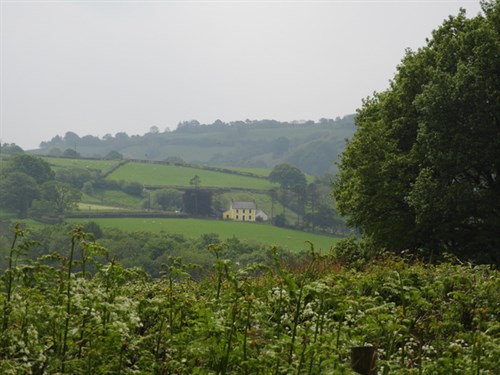
For me gardening is a source of constant renewal, of hope and
expecation and thanks to the help and support of many friends the
garden now looks as well as ever in late May. Although I have
reduced my 3 vegetable beds to 2 by grassing over one of them for
ease of maintenance, in all other respects the gardens look pretty
much the same as they have done in previous years. With no pressure
from NGS openings this year we have more time to enjoy the garden
and to get out and about which we have not been able to do for the
last 17 years. Hopefully this News Item will convey some of the
joys of the garden in May.
Weather
On the whole it was almost a perect May for the gardener.
Sunshine and long dry spells, good rain just when we needed it and
increasing warmth. A few late scares with overnight
temperatures close to freezing towards the end of the month, but
horti fleece once again came to the rescue to ensure no damage to
the most precious and tender plants. As always it seems here in
May, the wind was predominantly from the east which ensured
the dry weather to work outside and plan the days work in advance
so that the list of essential jobs is diminshing fast. 10 days over
20c max 24c on Sunday 8th. 15 nights under 10c min 0c on Wednesday
4th.
Garden Update
Lush growth everywhere, lawns needing mowing up to 5 times a
week after a good feeding. Like every other gardener in the land
however the weeds are growing quickeer than anything else!
Vegetables are doing well and some early crops of lettuce coming in
- cut and come again lettuce "Can Can", a long lasting
variety, "Lollo Rosso" to give colour and soft texture to a
mixed salad and an old favourite "Little Gem" a delightful form of
Cos and the perfect ingredient for the first of the Caesar
Salads.

Most of the 30 tomato plants have been planted in 15 -20 litre
pots in the large tunnel, half filled with well rotted sheep manure
and topped up with a home made, nutrient rich, heavy duty John
Innes compost.
As I have sown far less seed this year the Nursery does not take
up nearly as much time but there are still some special ornamental
plants and veggies to prick out and grow on especially
brassicas, sweetcorn, courgettes and runner beans.
Roses (over 60 of them) are looking good after heavy March
fertilising with speciality Rose Food and a good spraying for black
spot which is a constant concern in some of the roses, particularly
I find those from David Austin. Those from Delbard of France and
Poulson of Denmark seem to be much more black spot resistant.
The woodlanders are having a great time before the canopy grows
over them. Epimediuims have had a good year and brunneras look
great just now, with their lovely elegant stems of blue flowers
often likened to forget-me-nots but much nicer and nowhere near as
invasive.
Brunnera macrophylla in the woodland garden
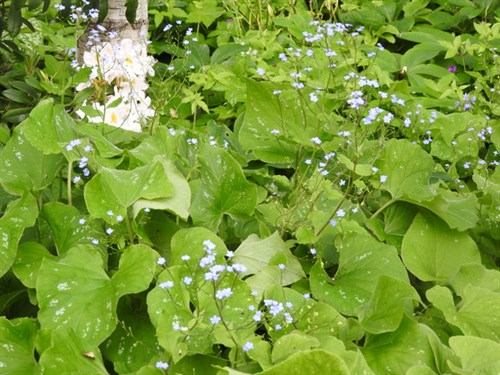
Other plants which had their special moments in May
included:-
Dwarf rhododendron "Bow Bells"
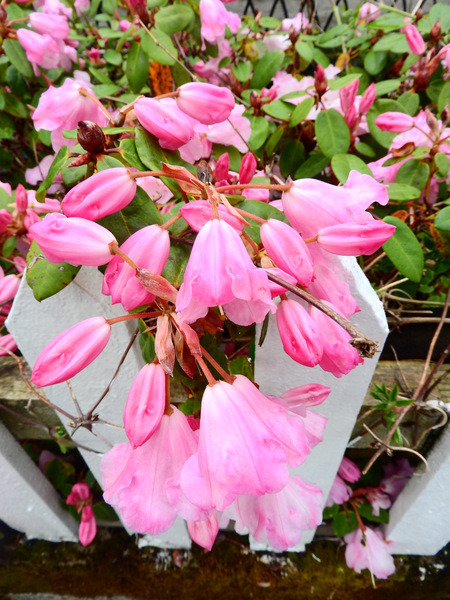
Paeonia mlokosewitschii

The wonderful white variegated form of honesty, so
beautiful I forgive its self seeding transgressions (unlike all the
others we grow!)
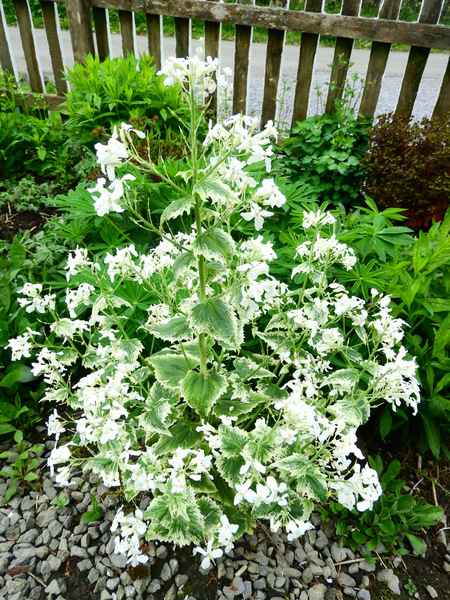
Maianthemum racemosum in a favourite position in the
cool moist shade of the stream garden

One of several forms of podyphylum in the gardens (for
moist shade) is P. hexandrum showing one of of its short lived
flowers and dramatic leaves, a stand out feature of the
genus
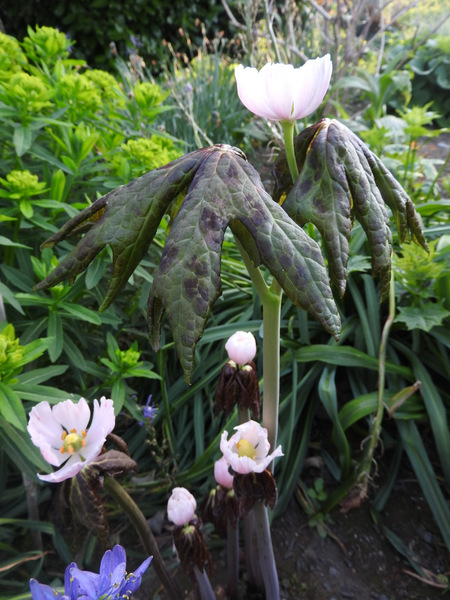
The elegant enchanting buttons of ranunculus
aconitifolius Flore Pleno commonly known as bachelor's
Buttons or Fair Maids of Kent/France

Native hawthorns have had a wonderful flowering
this Spring. On the old field boundary at Cilgwyn is this fine
specimen adorned with a mature pink clematis montana, a happy
combination.
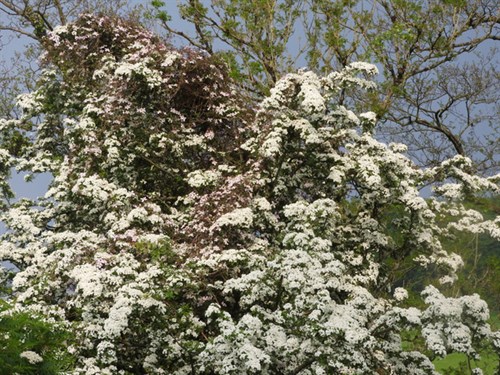
Having promised myself for some years, a shade area in the
nursery I finally got around to making one last week and all the
hostas and ferns seem to be enjoying it already.

I mentioned in last month's News that for
the first time in 40 years there will be no hanging baskets at
Cilgwyn Lodge. Moira came up with a cunning plan to go for a no
maintenance option, so now we have stainless steel twirlies where
the baskets used to be - 45 minutes saved each day at a
stroke!!
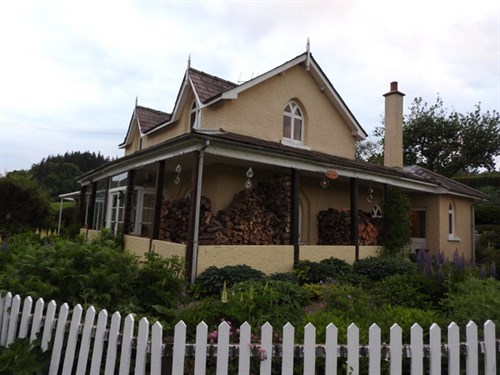
Finally and one of my favourite jobs of the year, is to remove
excess pond weed from the Paddock Pond. From a very early age I
have always had a fascination for pond life in the true sense of
the words! and have a vivid memory at around the age of 3 or 4, of
picking up a large frog with its backside facing towards me
which I learnt is not a good idea as it promptly urinated all
over the clean white shirt my mother had only just dressed me in
- she was not best pleased!
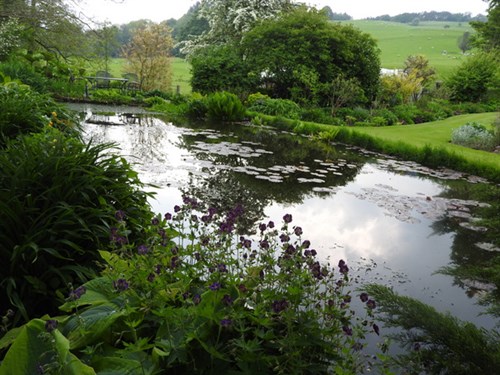
I always go into the pond in full length chest waders in
which I cut quite a dash! until losing my dignity I stumble
over numerous obstructions at the bottom of the pond! The best
thing of all is to be in nearly 5 feet of water at eye level
with the many Rudd and rapidly growing carp. There are myriads of
smaller pond life indicating the good health of the pond which has
a constant flow of fresh stream water, including freshwater shrimp,
dragonfly fly larvae at all stages of development, newts and efts
(their tadpole like young) and pond snails. Fortunately not a
single great diving beetle or water boatman was found - they are
voracious predators of smaller pond life including young fish of
which there are substantial numbers.
Perhaps the most unusual of the many plants in or at the
pond edge is this fine specimen of Orontium aquaticum from North
America
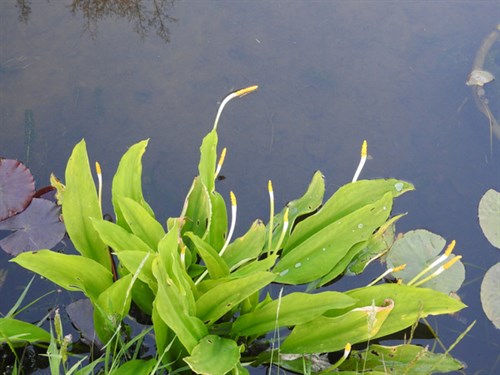
What's looking good?
Only 4 contenders for me currently at the peak of perfection:-
Bearded Iris, Euphorbias, Hostas and Viburnums. Sorry everything
else, your turn will come!
Last month at the Monet to Matisse exhibition in London I
marvelled at the many paintings of waterlilies by Monet over the
years, but the most impressionistic of all his paintings in the
exhibition were undoubtedly those featuring bearded iris, the
intense blobs of colours of various hues standing out from the hazy
background of the wonderful bluish spear like leaves.
This excellent Gold Medal winning display on The British
Iris Society stand at Malvern Spring Festival with more than an
impressionistic nod to Monet

We can't quite compete with that but we do have
some particularly fine cultivars here on the sunniest and best
drained of all our borders
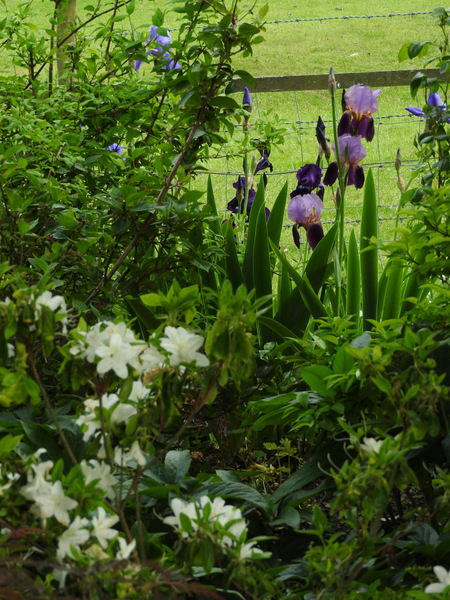
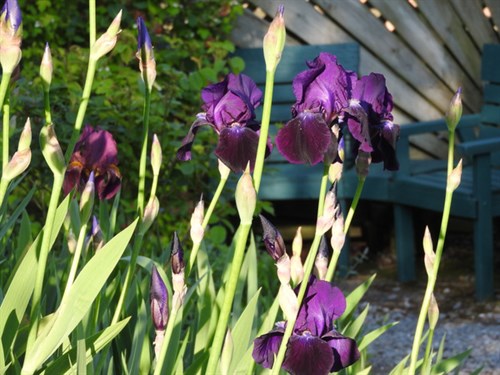
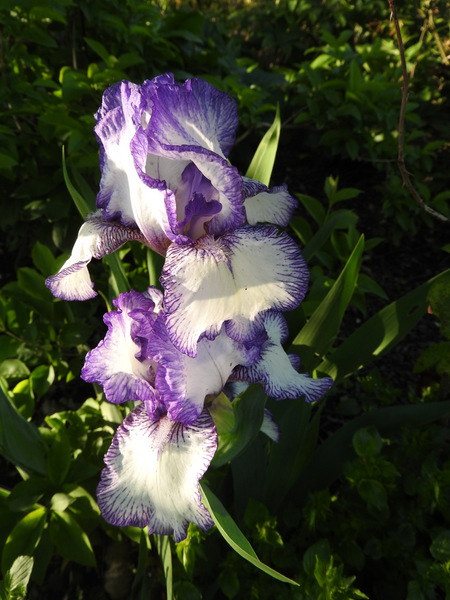
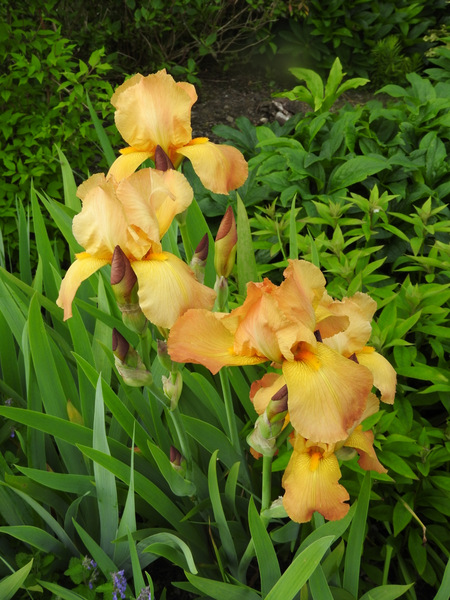
Euphorbias are in the very large euphorbiaceaea family, ( approx
300 genera and 7,000 species and countless cultivars from
extremes of habitats all over the world) They have a
good representation in the current edition of The Plant Finder,
with a wide range of choice for a variety of planting situations.
Although some have yet to flower this year, their structure and
leaves already make quite an impression in the borders and
they will look good until late summer. Some do seed around quite
vigorously and others spread by runners. They also emit an
irritating white latex like sap when cut.
This is a scented form and an unusual cross between e.
stygiana and e. mellifera. Called x pasteuri the 2 parent
plants first came together by chance! at Oxford University Botanic
Gardens where seedlings we first spotted by the then Director
of the gardens. It is a shrub like plant up to 8 feet and is said
to be hardy but in our frost pocket garden it stays in a large pot
and is given winter protection in a polytunnel before bringing
outside in May
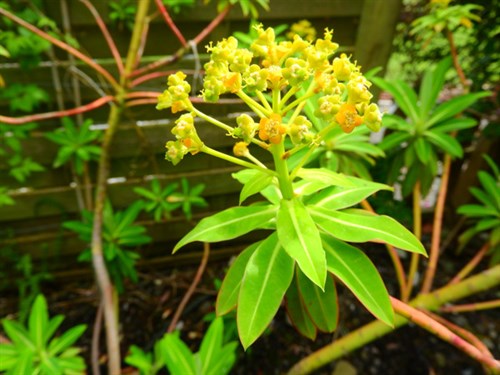
E.cyparassiasis a low growing, early flowering form that
is charming in its own way but spreads like the wind and needs
controlling.
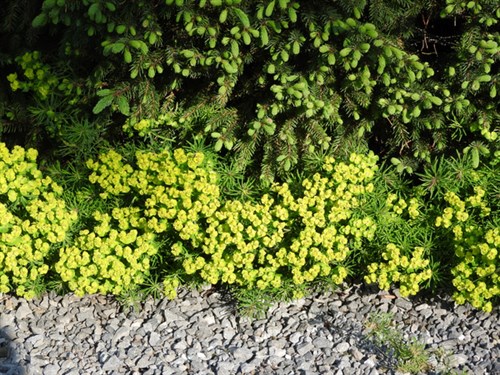
Unlike most of its hardy companions which are
yellow/lime green, e. griffithii has this wonderful orange
red infloresense and burnt orange red hues to its leaves. For us it
grows (and spreads!) exceptionally well in part shade and very dry
soil. Looks great in May with bluebells.
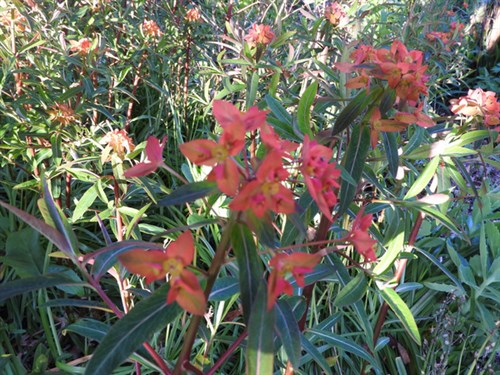
Emerging leaves of later flowering
E.shillingii

E. palustris "Walenburgs Glorie" is one of the earliest
flowering taller forms and is unusual in that it prefers
permanently damp soil.
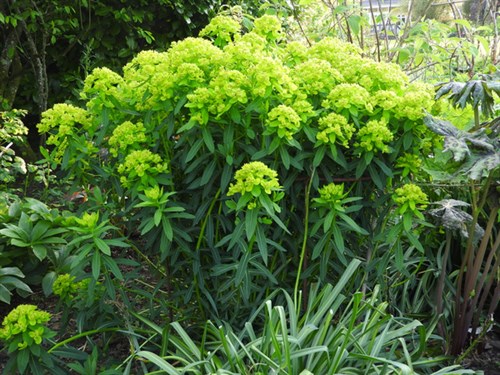
A recent acquisition is e. cornigera with fantastic leaf
markings. I haven't yet seen it in flower.
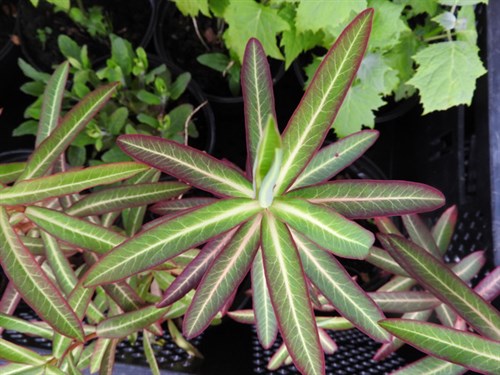
One of my lasting gardening regrets during 40 years at Cilgwyn,
is in not planting more trees and shrubs in the early days. However
as a passionate herbaceous plantsman and dedicated veg grower,
these always took priority. I did plant some trees and shrubs and
it is only now that they are mature I realise their impact and ease
of maintenance. Fortunately of the shrubs I did plant many were
viburnums of various cultivars and several species
forms. Collectively they cover a flowering period from
late March to June, most having good scent and some autumn colour.
There are about 250 species and cultivars available in the UK and
we have just a small fraction, but they have for the most part,
proved to be reliable and robust, even though they have a reputaion
for sudden death syndrome from numerous causes, most commonly honey
fungus.
V. plicatum is a vigorous form with tiered branches. As
you can see I didn't give this one enough room when I planted it
over 20 years ago!
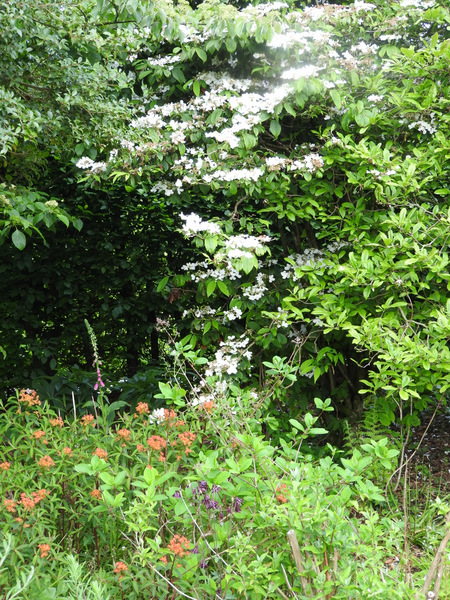
Attractive lace cap flowers of V. sargentii
onondaga
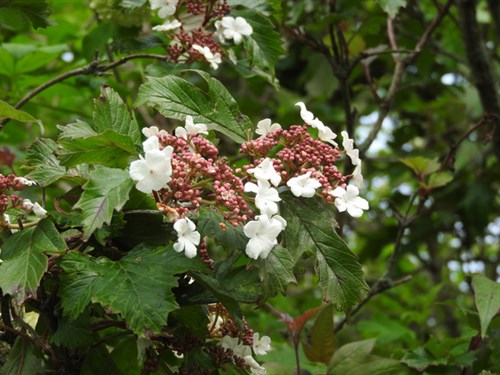
A more recent planting of a fairly new form, V.
Kilimanjaro which is upright with good flowers, and in autumn has
red berries and good leaf colour
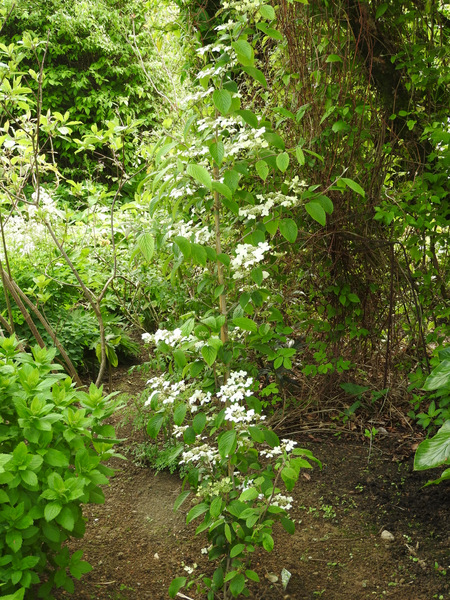
The largest in the garden at 15 feet is
v.rhytidophyllum with shiny leathery leaves generous flowers and
black berries later in the year. It is evergreen
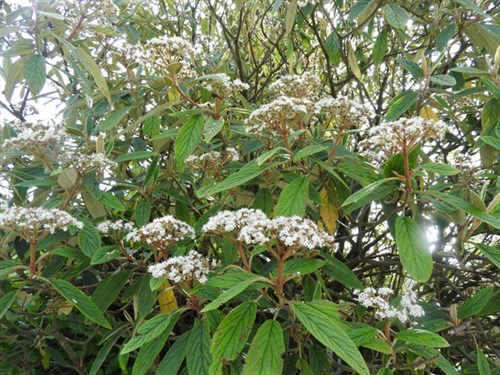
And finally a long term garden favourite the so called
snowball tree with round heads of flowers on a rather straggly,
tall shrub, is v. opulis sterile
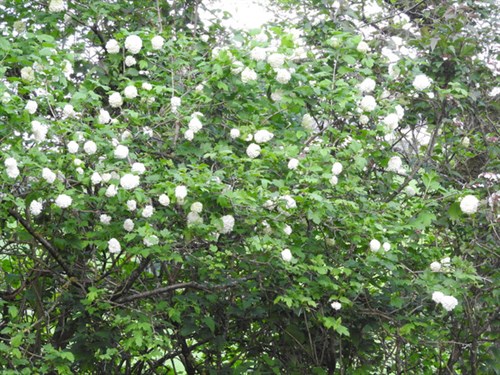
Many regular visitors to the gardens and the website will
know of my fanatical affection for hostas stretching back
over 40 years. I am losing count of the cultivars we have but it
must now exceed well over 200. They have been desperately slow this
Spring but at last they have burst into full growth
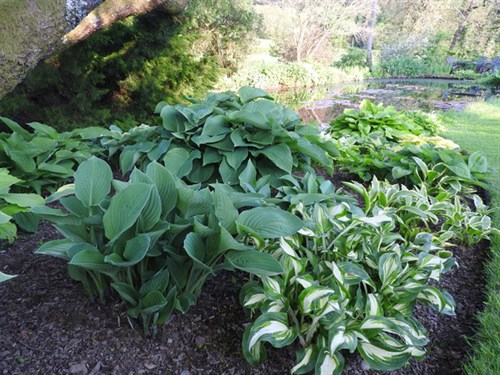
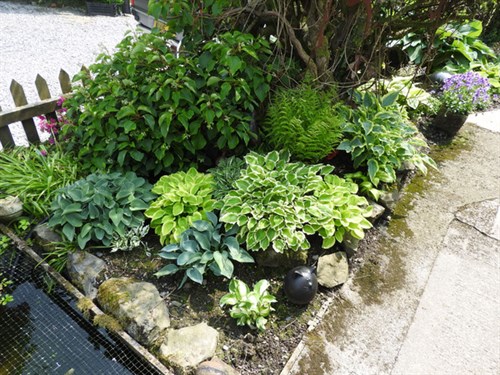
A huge plant of H. Sagae which is 4 feet across
and 2 feet tall first planted 12 years ago.
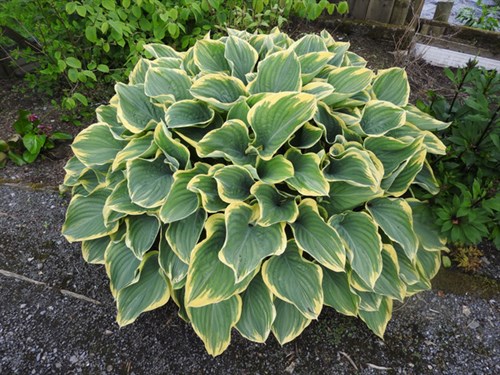
A real special favourite of mine is the
wonderfully named Lakeside Love Affaire from the well respected
Lakeside Nursery in the US. The colours are just spellbinding
-funnily enough the Lakeside Nursery has a cultivar of that
name!

Alongside the hostas behind the Koi Pond is a growing
colony of the shuttlecock fern which revels in the same moist part
shaded position as the hostas.
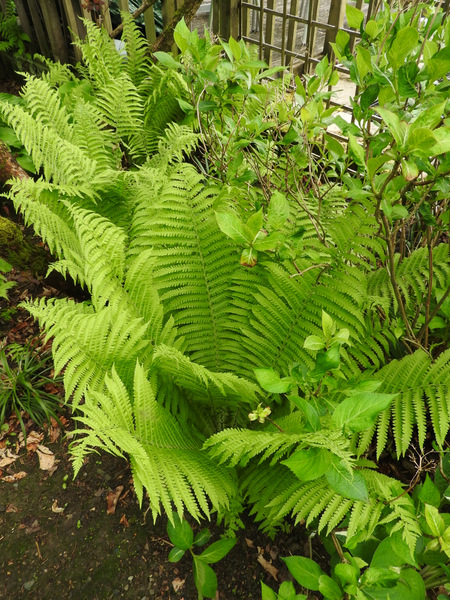
Just before going to print I was forced to relent on only
including 4 genus, as the first of the big poppies have just
started to flower, a significant event in the gardening year for
those of us who grow and love them!
Meconopsis fertile group "Lingholm"
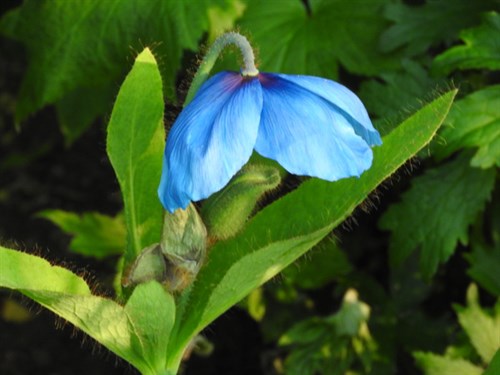
Papaver orientale "Beauty of Livermere" at
twilight when red seems to show its true colour

Wildlife and Countryside
There are baby birds everywhere, some a lot more cute than
others. We have found several nests in the gardens. The robins I
reported on last moth managed to fledge their young successfully,
and in the same pot store area a pair of the delightful pied
wagtails raised a brood that was easier to monitor than the robins
and in just 18 days or so the eggs hatched and the fledging time
was about the same - new life in just over a month. Incredible. The
young birds were quite vulnerable in the nest because it was open
at the front and accessible to the pair of magpies and their young
which also had their nest in the gardens. However I managed to make
the nest secure by boarding over the pot store, a rather
Heath Robinson job but it did the trick and it was so good to see
the young wagtails fly away, to scuttle all over the house roof we
hope, in their permanent quest for insects.
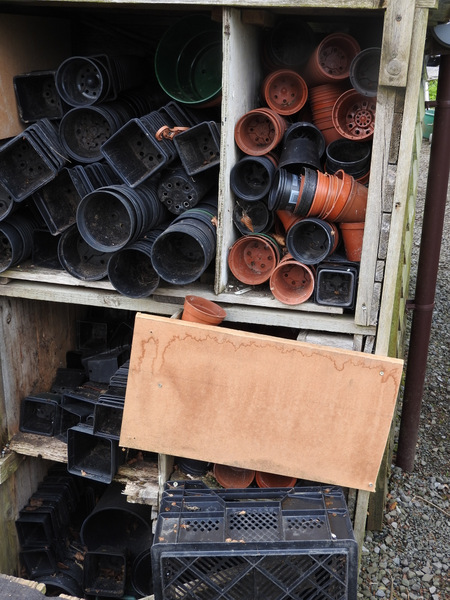
A most welcome summer visitor was the return after some years of
redstarts, a pair of which chose for their nest, a convenient
hole in the soffit of verndah roof.
On the wildflower front the wood anemones were outstanding
everywhere we went, none more so than in woodland adjacent to the
M50 in Gloucestershire, close to where we saw the wild daffodils
last month. I would love to have taken a pic but as so often with
some of the most special sitiations, there was nowhere to stop!
The latest star plant is the hedge parsley, cow parsley,
queen Anne's lace - whatever is your local name for anthriscus.
There is not a lane around here that isn't adorned with it and the
hope is that the local council isn't too quick to cut back the
verges this year.
Visits
As many readers will know we are sadly not opening the garden
this year for the NGS. It does seem strange after 16 consecutive
years of opening. However the good news is that just 5 miles away
from us, our very good friends Robert and Barry are opening their 2
acre garden for the NGS on 5 June, which will be their first of
what we hope will be many openings in the future. It is a
relatively new garden, only 4 years in the making, but already
looking good with herbaceous and shrub borders, new large stream
garden, superb sweeping manicured lawns and fantastic views across
upland landscape in the Brecon Beacons National Park. We shall be
there with a terrific range of plants for sale, there will be home
made teas and all this for only £3.50 !! Please come and support
them on the NGS Festival Weekend. Garden signposted with
yellow NGS signs from Llangadog and Llandovery.
Gelli mydog surrounded by its ring of
hills
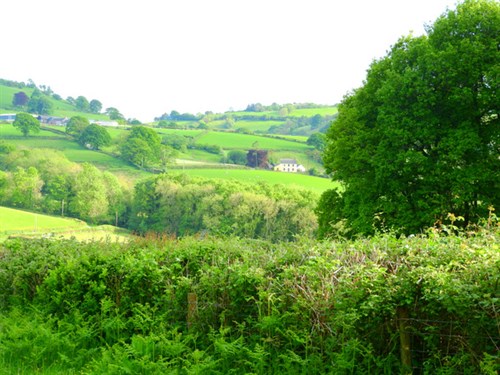
Other vists during the month included Malvern Spring Festival
and Llwyn Garreg near Whitland For more details of this
outstanding garden and opening dates go to www.llwyngarreg.co.uk
Some pics from Malvern




One of the best things we saw there was the
competition for primary schools to design a garden based on a
Shakespearean theme. There were some outstanding efforts of which
this was judged the best.

Great to see involvement of children in gardening at such
an early age many of whom will have no mentors in their families as
most children of my generation had. As Gertrude Jekyll once
famously remarked that "Love of gardening is a seed that once sown,
never dies"